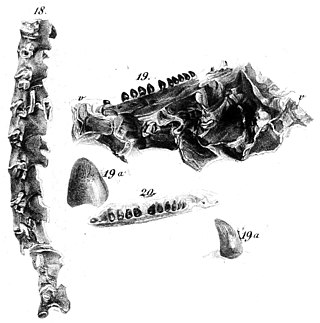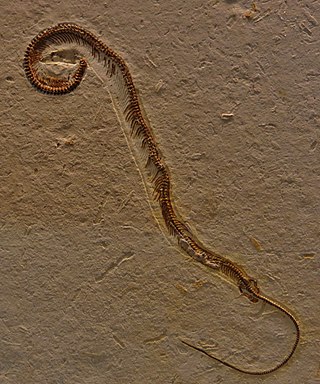
Ophidia is a group of squamate reptiles including modern snakes and reptiles more closely related to snakes than to other living groups of lizards.

Mosasaurs are an extinct group of large aquatic reptiles within the family Mosasauridae that lived during the Late Cretaceous. Their first fossil remains were discovered in a limestone quarry at Maastricht on the Meuse in 1764. They belong to the order Squamata, which includes lizards and snakes.

Pythonomorpha was originally proposed by paleontologist Edward Drinker Cope (1869) as a reptilian order comprising mosasaurs, which he believed to be close relatives of Ophidia (snakes). The etymology of the term Pythonomorpha comes from the Greek Python and morphe ("form"), and refers to the generally serpentine body plan of members of the group. Cope wrote, "In the mosasauroids, we almost realize the fictions of snake-like dragons and sea-serpents, in which men have been ever prone to indulge. On account of the ophidian part of their affinities, I have called this order Pythonomorpha." Cope incorporated two families, the Clidastidae and the Mosasauridae.

Aigialosauridae is a family of Late Cretaceous semiaquatic pythonomorph lizards closely related to the mosasaurs. Regarded by some paleontologists as a distinct monophyletic group and by others as an adaptive grade within the basal mosasauroids, recent molecular and morphological data suggests that they are the oldest known members of the lineage leading to the mosasaurs.

Adriosaurus is an extinct genus of squamate which lived in what is now Slovenia and other parts of Europe during the Late Cretaceous. It was small, snake-like reptile, with type species measuring up to 30 cm (12 in) in length. This is the first fossil record of vestigial limbs in lizards. It lost its manus and forearm completely in order to elongate its axial skeleton. These unique anatomical features led to discussions of the evolutionary patterns of limb reduction in Squamata.

Kaganaias is an extinct genus of basal and oldest dolichosaur that lived in what is now Japan during the Early Cretaceous. Kaganaias was semi-aquatic and is the only known aquatic squamate known from before the Cenomanian stage of the Cretaceous. It is also the first to be found in an inland area, instead of on the coast where aquatic squamates are commonly found. Its generic name is derived from Kaga Province, the old name for the Ishikawa Prefecture where the specimens were found, while the species name hakusanensis comes from the mountain that gives its name to Hakusan the city near its find site. The geological formation in which the specimens were found, the Kuwajima Formation, stands alongside the Tetori River and has been the site of numerous other finds including molluscs, dinosaurs, fish, and pterosaurs.

Dolichosaurus is an extinct genus of marine squamate of the Upper Cretaceous Cenomanian chalk deposits of England. It is a member of the family Dolichosauridae. It was a small reptile measuring 0.5–1 m (1.6–3.3 ft) long. It had an elongate neck resulting from an increased number of cervical vertebrae.

Mosasauroidea is a superfamily of extinct marine lizards that existed during the Late Cretaceous. Basal members of this group consist of small semiaquatic forms with terrestrial limbs ("plesiopedal"), while laters members include larger fully aquatic paddle-limbed ("hydropedal") forms commonly known as mosasaurs. These were traditionally grouped within their own separate families, the Aigialosauridae and Mosasauridae respectively. However, phylogenetic studies have since found plesiopedal mosasauroids to be a non-monophyletic group, with some taxa nestled within the mosasaurids.

Tethysaurus is an extinct genus of tethysaurine mosasauroid from the Early Turonian period. The only species is Tethysaurus nopcsai.

Yaguarasaurus is an extinct genus of mosasauroid from the Late Cretaceous (Turonian) period of Colombia, South America. The remains discovered were defined as a new genus and species of mosasaurid, Yaguarasaurus columbianus, by the Colombian paleontologist María Páramo, former director of the Museo de Geología José Royo y Gómez of INGEOMINAS in Bogotá. The first fossils remains of this animal suggested a cranial length of 47 centimetres (19 in) and a total length of 5 metres (16 ft); an additional skull that measures 87 centimetres (34 in) long implies a larger size.

Carsosaurus is a genus of extinct amphibious reptiles, in the mosasaur superfamily, containing only the species Carsosaurus marchesetti. It is known from a single individual that lived during the Upper Cretaceous in what is now Slovenia. The specimen is well-preserved, containing many different bones as well as some skin impressions and sternal cartilage. While more remains are needed to be certain, it is generally thought to belong to Aigialosauridae. In life, it was an amphibious creature that spent most of its time on land, although its later relatives would become fully aquatic.
Komensaurus is a genus of basal aigialosaurid mosasauroid from the Late Cretaceous period. It was found at Komen in Slovenia in limestone dating from the Cenomanian. It was earlier referred to as the "Trieste aigialosaur". In 2007, the type species Komensaurus carrolli was named. Its holotype, specimen MCSNT 11430, was discovered in Slovenia and lived alongside the related Carsosaurus.

Aigialosaurus is an extinct genus of Late Cretaceous marine or semiaquatic lizard classified as part of the family Aigialosauridae within the Mosasauroidea. Exclusively found in deposits of Cenomanian age near Hvar, Croatia, the genus contains one valid species, A. dalmaticus. According to recent molecular and morphological data, Aigialosaurus is the oldest known member of the lineage leading to large Cretaceous marine reptiles called mosasaurs, a group most closely related to snakes among living squamates. It was a relatively small reptile with a complete specimen measuring 65 cm (2.13 ft) long.
Acteosaurus is an extinct genus of aquatic lizard that lived in the upper Cretaceous period. Its species, A. tommasinii and A. crassicostatus, were described in 1860 and 1993. Though A. crassicostatus is probably a junior synonym for Adriosaurus suessi, A. tommasinii was found to be similar to coniasaurs, mosasauroids, and a sister taxon to modern snakes in 2010.

Coniasaurus is an extinct genus of Late Cretaceous marine squamates that range in age from Cenomanian to Santonian. It was first described by Richard Owen in 1850 from lower Cenomanian chalk deposits in southeast England (Sussex). Two species have been described from this genus: C. crassidens, known from Cenomanian to Santonian deposits from southeast England, Germany and North America, and C. gracilodens from the Cenomanian of southeast England.

Tetrapodophis is an extinct genus of lizard from the Early Cretaceous (Aptian) aged Crato Formation of Brazil. It has an elongate snake-like body, with four limbs. Tetrapodophis has been considered by some authors to be one of the oldest members of Ophidia. However, this classification has been disputed by some other authors, who identify Tetrapodophis as a dolichosaurid much less closely related to snakes.

This timeline of mosasaur research is a chronologically ordered list of important fossil discoveries, controversies of interpretation, and taxonomic revisions of mosasaurs, a group of giant marine lizards that lived during the Late Cretaceous Epoch. Although mosasaurs went extinct millions of years before humans evolved, humans have coexisted with mosasaur fossils for millennia. Before the development of paleontology as a formal science, these remains would have been interpreted through a mythological lens. Myths about warfare between serpentine water monsters and aerial thunderbirds told by the Native Americans of the modern western United States may have been influenced by observations of mosasaur fossils and their co-occurrence with creatures like Pteranodon and Hesperornis.

Ophidiomorpha is a proposed clade composed of snakes and a number of extinct squamate groups. The clade was defined by Placi and Caldwell (2007) as a node-based clade containing the most recent common ancestor of dolichosaurs, adriosaurs, Aphanizocnemus, and fossil and extant Ophidia and all of its descendants.

Mosasauria is a clade of aquatic and semiaquatic squamates that lived during the Cretaceous period. Fossils belonging to the group have been found in all continents around the world. Early mosasaurians like dolichosaurs were small long-bodied lizards that inhabited nearshore coastal and freshwater environments; the Late Cretaceous saw the rise of large marine forms, the mosasaurids, which are the clade's best-known members.
















